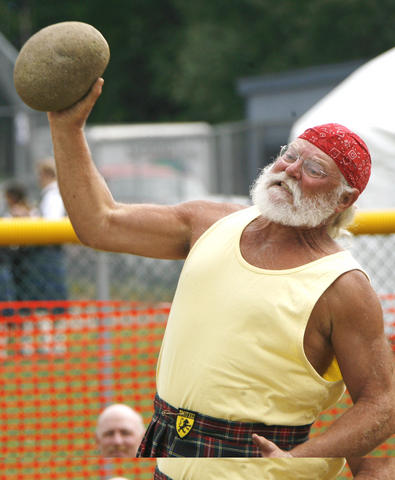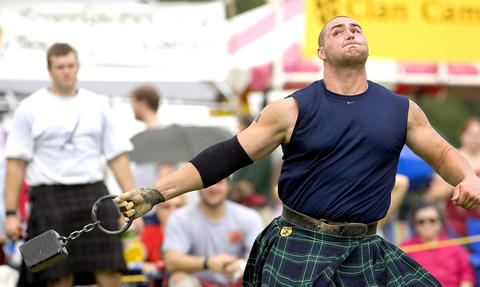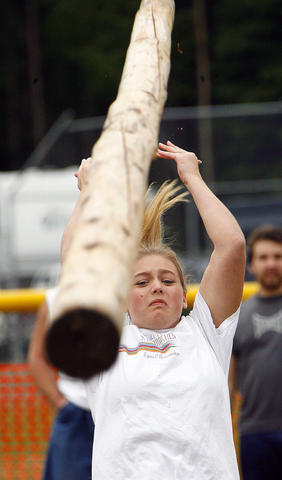Swinging an antique sword wildly above his head as the rain bucketed down Sunday, Gregor Edmunds stood atop the podium, the newly crowned champion of the World Highland Games. For the first time in 12 years, the competition returned to Scotland, so it was only fitting for a Glaswegian to win it.
Of the 12 linebacker-sized men clad in Tartan kilts, the 193cm and 130kg Edmunds proved the most consistent over eight tests of strength. They ranged from throwing stones, weights and hammers for both distance and height to the iconic caber toss in which competitors try to flip a 6m, 55kg pole.
For a Scottish tradition that ranks alongside bagpipes and haggis - both in abundant supply last weekend - one detail seemed odd. Behind the podium, five American flags blew in the wind.

PHOTO: AP
They represented the five Americans in the field. Over the past century, Highland sports have found a niche in the US, which now produces some of the top competitors in the world. The US has more Highland Games and Scottish festivals than any country in the world with more than 200 events a year, blending the atmospheres of a track meet and a county fair.
"It's just really caught on in the US," said Harrison Bailey III, a Highland Games athlete and high school principal from Easton, Pennsylvania. "I think we have such a strong track and field presence in the US that a lot of guys make that transition."
In Scotland, however, the traditional sports have been on a steady decline. David Webster, the secretary general of the World Federation of Heavy Events, acknowledged that there was cause for concern, but no fear of Highland sports dying.

PHOTO: AP
"They've been around for 1,000 years and they'll keep on being with us," he said. "But it is getting harder and harder to find sponsorship."
Webster, a 78-year-old retired gym teacher, has been organizing games since 1946. Wearing a kilt, bonnet and woolly knee socks - complete with a hunting knife tucked in the side - he paced around the field, serving as commentator for the events and recounting the history of the games to anyone who would listen.
The earliest records of Highland games date to the 11th century when, as the story goes, King Malcolm Canmore of Scotland wanted to find the fastest man in his clan because he needed a messenger. So he organized a hill race and while the villagers waited for the runners to come down, they passed the time by throwing stones and weights.

PHOTO: AP
Clan chieftains also used the games to find their strongest men, Webster said. That way, each chieftain had his champion and could challenge those in other clans as a substitute for battles.
Highland games were eventually formalized in the 19th century. Sir Walter Scott, author of Ivanhoe, arranged a display for the visit of King George IV to Edinburgh in 1822. It included a meeting of the clans, a piping competition, traditional dancing and the heavy throwing events, which are the four elements required for any games today.
The sport soon became a cultural export. In 1889, a party of Scots was invited to the Paris Exposition to put on a Highland games show. Sitting in the crowd was Baron Pierre de Coubertin, who created the modern Olympics five years later.
"He included putting the stone, throwing the weight for distance, the pole vault, throwing the hammer - all good Scottish things - having seen them there," Webster said.
Scottish immigrants spread their traditions as far as Canada, Australia and New Zealand. But Webster said it was Donald Dinnie who firmly established Highland games during tours in the US, inspiring a group of amateur athletes in New York.
Last weekend, there was one New Yorker taking on the Scots. David Barron, a Manhattan lawyer, competes in 10 to 15 games a year.
"The guy who wins this weekend will make £1,000 (US$2,032), maybe £2,000," he said. "And that's on the high end. You've got to be doing it for the love of it."
His fellow American Sean Betz, a personal trainer from Omaha, Nebraska, said that even without the high stakes of most world-class sporting events, Highland games provided a better atmosphere for competition.
"There's no animosity at all," he said. "You're not as nervous and you're not rooting for people to mess up."
The caber toss was the last event on the schedule and the rain-sodden fans were rewarded with a Scottish victory Sunday. Edmunds's throw was good enough to defeat the five-time champion Ryan Vierra, a professional Highland games athlete of Hilmar, California. What the championship lacked in prize money, it more than made up for by staying true to the sport's local roots. Edmunds put down his sword for a moment and waved his trophy in the air: a bottle of 25-year-old Scotch.
The only thing threatening to overshadow the championships was a caber thief. Last week, while the poles were being soaked in a local loch to attain the necessary weight, one of them was stolen. The perpetrator and 6m pole are still at large.

May 11 to May 18 The original Taichung Railway Station was long thought to have been completely razed. Opening on May 15, 1905, the one-story wooden structure soon outgrew its purpose and was replaced in 1917 by a grandiose, Western-style station. During construction on the third-generation station in 2017, workers discovered the service pit for the original station’s locomotive depot. A year later, a small wooden building on site was determined by historians to be the first stationmaster’s office, built around 1908. With these findings, the Taichung Railway Station Cultural Park now boasts that it has

Wooden houses wedged between concrete, crumbling brick facades with roofs gaping to the sky, and tiled art deco buildings down narrow alleyways: Taichung Central District’s (中區) aging architecture reveals both the allure and reality of the old downtown. From Indigenous settlement to capital under Qing Dynasty rule through to Japanese colonization, Taichung’s Central District holds a long and layered history. The bygone beauty of its streets once earned it the nickname “Little Kyoto.” Since the late eighties, however, the shifting of economic and government centers westward signaled a gradual decline in the area’s evolving fortunes. With the regeneration of the once

The latest Formosa poll released at the end of last month shows confidence in President William Lai (賴清德) plunged 8.1 percent, while satisfaction with the Lai administration fared worse with a drop of 8.5 percent. Those lacking confidence in Lai jumped by 6 percent and dissatisfaction in his administration spiked up 6.7 percent. Confidence in Lai is still strong at 48.6 percent, compared to 43 percent lacking confidence — but this is his worst result overall since he took office. For the first time, dissatisfaction with his administration surpassed satisfaction, 47.3 to 47.1 percent. Though statistically a tie, for most

In February of this year the Taipei Times reported on the visit of Lienchiang County Commissioner Wang Chung-ming (王忠銘) of the Chinese Nationalist Party (KMT) and a delegation to a lantern festival in Fuzhou’s Mawei District in Fujian Province. “Today, Mawei and Matsu jointly marked the lantern festival,” Wang was quoted as saying, adding that both sides “being of one people,” is a cause for joy. Wang was passing around a common claim of officials of the People’s Republic of China (PRC) and the PRC’s allies and supporters in Taiwan — KMT and the Taiwan People’s Party — and elsewhere: Taiwan and